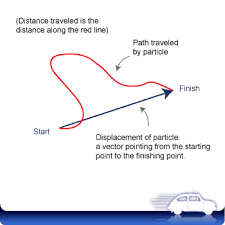Motion in Physics Velocity part2
Motion in Physics Velocity part2 continues..
When is velocity said to have change
Velocity is a vector quantity. So, velocity has a magnitude
as well as a direction. The magnitude of velocity is equal to the speed of the
body. If either of the two, i.e., either speed or direction changes, velocity
is said to have changed. Thus, the velocity of a body change due to a change
in its speed, its direction, or both.
Let us consider a
car travelling (towards east) at a constant speed of 10 m/s. Then, it has a
constant velocity in that direction. When the takes a turn, its velocity
changes although its speed remains constant. When the car is at right angles to
its original direction, the its velocity (towards east) becomes zero, the speed
remaining constant. When the car is travelling in the direction just opposite
to the original direction, it has a negative velocity. So, the velocity of a
moving object changes due to a change in its direction.
What is meant by uniform velocity (or constant velocity)
Uniform (or constant) velocity is defined as,
“when a body
travels in a straight line (in a particular direction) and covers equal
distances in equal intervals of time, it is said to have uniform velocity.”
Thus, a body is
said to have uniform (or constant) velocity if it covers equal distances in
equal intervals of time in a particular direction.
Thus, a body
travelling with a constant speed along a straight line in a particular
direction has uniform velocity.
What is meant by non-uniform velocity
Non-uniform velocity
is defined as,
“A body is said
to have non-uniform velocity when it covers unequal distances in equal time
intervals in a particular direction, or when it covers equal distances in equal
intervals of time, but changes its direction during the motion.”
A car turning a corner at constant speed has non-uniform
velocity.
What is meant by average velocity of a body moving in a
particular direction
If the velocity of a body in a particular direction changes
continuously at a uniform rate, then the arithmetic mean of the initial and
final velocities over a given period of time, is called the average velocity
in that direction. So, Average velocity in a particular direction,
vav
= (Initial velocity + Final velocity)/ 2
If, u is the initial velocity, and v is the final velocity in
a particular direction, then
Average velocity in a particular direction, vav =
(u + v)/2
For more updates keep visiting
Thanks
SmartiesGeeks (Sashi kant)








nice
ReplyDelete